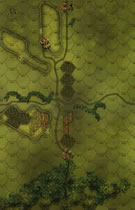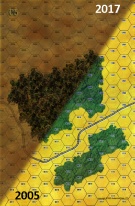|
Yauco To Hell With Spain! #6 |
||
|---|---|---|
| (Defender) Kingdom of Spain | vs | United States (Attacker) |
| Formations Involved | ||
|---|---|---|
| Kingdom of Spain |  |
25th Patria Battalion |
| Kingdom of Spain |  |
Cazadores de la Patria |

|
| Overall Rating, 3 votes |
|---|
|
3
|
| Scenario Rank: --- of 957 |
| Parent Game | To Hell With Spain! |
|---|---|
| Historicity | Historical |
| Date | 1898-07-26 |
| Start Time | 04:30 |
| Turn Count | 16 |
| Visibility | Day & Night |
| Counters | 20 |
| Net Morale | 1 |
| Net Initiative | 2 |
| Maps | 2: 33, 6 |
| Layout Dimensions | 56 x 43 cm 22 x 17 in |
| Play Bounty | 153 |
| AAR Bounty | 166 |
| Total Plays | 2 |
| Total AARs | 1 |
| Battle Types |
|---|
| Delaying Action |
| Exit the Battle Area |
| Inflict Enemy Casualties |
| Road Control |
| Conditions |
|---|
| Terrain Mods |
| Scenario Requirements & Playability | |
|---|---|
| Eastern Front | Maps |
| Fall of France 1 | Maps |
| To Hell With Spain! | Base Game |
| Introduction |
|---|
|
With the Regular Army committed to the Cuban campaign and the occupation of the Philippines, most additional American forces would have to be drawn from the volunteer state militias that had been mustering since the outbreak of war. These formed the bulk of the forces with which General Nelson Appleton Miles landed at Guanica, Puerto Rico. Miles’ landing site was a surprise to everyone, including the Americans. The approved war plan had Miles landing all his forces at Cape San Juan on the northeastern tip of the island and then making a relatively short march westward to take the Puerto Rican capital of San Juan. But Miles rejected that in favor of landing at several points on the south coast of Puerto Rico, after which his troops would fan out across the island to crush all opposition. Miles didn’t bother to get the change approved by the Secretary of War nor President McKinley; he simply went ahead and did it unilaterally. Many were outraged by Miles’ actions, which violated the maxim that one never splits one’s forces in the face of the enemy unless circumstances require it. Alfred Thayer Mahan declared Miles’ actions “. . . a military stupidity so great, that I can account for these acts only by a kind of obsession or vanity, to do a singular and unexpected thing.” After a short skirmish on July 25 to drive the small Spanish garrison out of Guanica, the lead units of the Puerto Rico invasion secured their beachhead while local Spanish officials telegraphed news of the invasion to the Governor of Puerto Rico, Manuel Macias y Casado. Macias ordered forces southward to block any American breakout from the beachhead, while Miles sent Brigadier General G. A. Garretson on a night march northeastward to seize the railroad station at Yauco. In the wee hours of the morning of the 26th, Garretson’s forces met with a Spanish force under Coronel Tenente Francisco Puig, blocking the road at Hacienda Desideria. |
| Conclusion |
|---|
|
Spanish resistance was unexpectedly strong and caused some confusion, but in the end the volunteers drove the Spanish off with only a few casualties on either side. Colonel Puig’s troops retreated to the north coast of the island after abandoning most of their heavy equipment at Yauco, a fact which shamed Colonel Puig so much that he committed suicide rather than face the possibility of public disgrace. The 6th Massachusetts Volunteers marched through Yauco and on to Ponce, where they helped secure the surrender of that city. However, shortly thereafter General Miles launched an investigation that ended with the resignations of several officers of 6th Massachusetts plus the replacement of the regimental commander with a Regular Army colonel. Reports of the proceedings cited the officers who resigned with failure to maintain troop discipline and being absent from their troops in battle. However, other reports blame some of the resignations on the fact that General Garretson did not like dealing with the African-American officers and troops of Company L. |
| Bullets dancing in the dark | ||||||||||||||
|---|---|---|---|---|---|---|---|---|---|---|---|---|---|---|
The Americans start with 2 unsupported battalions of volunteers. The Spanish, though inferior in numbers, have the advantage of a battalion of regular infantry. That, combined with the disparity in the officer corps, give the Spanish a serious qualitative advantage. Due to the small size of the forces and the amount of open ground, the Spanish cannot simple form a hedgehog at the crossroad. They need an active defense. My opponent set up around the crossroads on board 33 with his cavalry screening his right flank, from the hill. This left a wide gap through which I charged. This drew my opponent off the crossroads. At this point, the infantry fight problems began to manifest themselves. Specifically that infantry does not our run other infantry very well. I had achieved the break-in, but could not get enough of a breakthrough. I sent my major, a rather worthless officer, and 2 companies running for the exit. Holding the opening caused a near collapse of the remaining force. My general and 3 companies were demoralized and nearly everyone else was disrupted. Fleeing and some adroit maneuvering allowed for my recovery. It also left the Spanish free to maneuver too. 2 companies were isolated for the rest. The Spanish infantry and cavalry closed in on them. Becoming demoralized and caught in a crossfire, they were annihilated as the general and other infantry tried to beak the crossfire and rescue them. The game ended with the Americans able to fulfill 1 of their 3 objectives. Spain had a minor victory. This scenario is rather brittle. The game was largely decided before sunrise, about 6- or 7 turn in. |
||||||||||||||
| 0 Comments |

 HwSp005
HwSp005 















